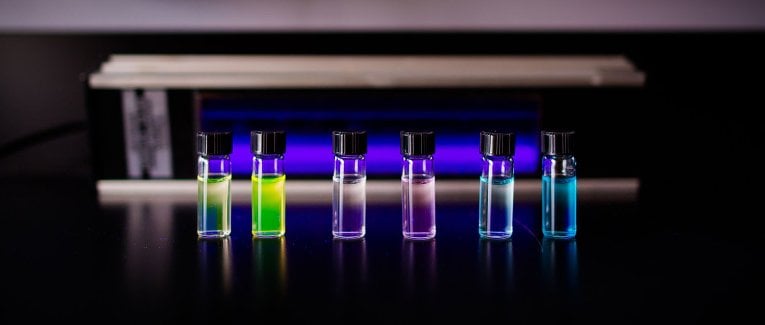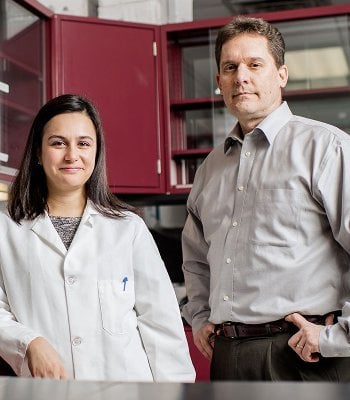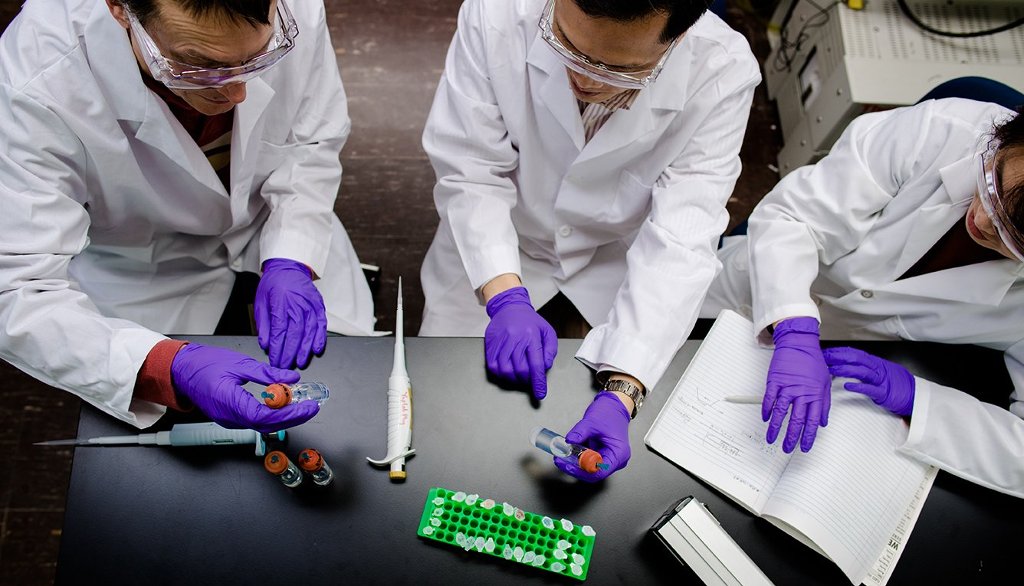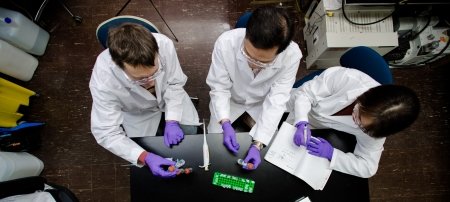John Diebel says commercializing university technology is a little like playing football.
“It’s a game of patience,” the assistant director of commercialization in Michigan Tech’s Office of Innovation and Commercialization explains. “You just try to move the ball forward one play at a time.”
That’s exactly what Yoke Khin Yap is doing with his high-brightness fluorophores technology and his spin-off company, StabiLux Biosciences Inc. Yap is a professor of physics at Michigan Tech.
High-brightness fluorophores are dyes that fluoresce in different colors and degrees of brightness. They are used in machines called flow cytometers to detect diseased cells in blood. StabiLux’s high-brightness fluorophores can detect those cells in smaller amounts and much faster than has been possible up to now.
The tunable or adjustable brightness enables more cells to be identified without the colors interfering with each other. And the enhanced signals they emit enable detection of cells that are not detectable using current methods.

Christan Carson, vice president for research and development at Becton Dickinson Biosciences, calls Yap’s invention “a game changer.” It’s taken nearly a decade of lab work, market research, and fundraising to change the game this far. But the hard work has paid off—the product could be in the marketplace within the next year, based on additional funding.
Yap was on sabbatical in 2008, working on a nanomolecule, when he realized that it had potential for use in biomedical imaging. Five years of painstaking lab work followed, supported in part by Michigan Tech’s own Research Excellence Fund.
Finally, in 2013, Yap was ready to take the next step toward a marketable product. A $44,000 grant from the Michigan Economic Development Corporation’s (MEDC) Michigan Initiative for Innovation and Entrepreneurship launched that effort.
In 2014, Yap’s team was accepted into the National Science Foundation’s I-Corps team program, which trains scientists to do market research. The I-Corps project allowed his team to identify the market of flow cytometry and develop a viable business plan. Then the state stepped back in with grants from the Tech Transfer Talent Network (T3N), a collaboration among universities to support early-stage commercialization projects by providing funding for mentors-in-residence who assist in the business side of the research commercialization plan. At that point, in 2014, Yap established StabiLux Biosciences in partnership with Superior Innovations, a for-profit company founded with alumni donations to nurture Michigan Tech innovations.
"Commercializing university technology is a little like playing football."
In 2015, the University pitched in again, with a Commercialization Milestone grant and funding from the College of Sciences and Arts and Yap’s Department of Physics. The following year, the first angel investor appeared, followed by the MEDC’s Business Accelerator Fund and MTRAC, the Michigan Translational Research and Commercialization program.
By 2016, Yap’s project attracted more NSF funding, through its Small Business Technology Transfer Program. Then MEDC provided $30,000 from its Small Company Innovation Program (SCIP), and Superior Innovations kicked in $10,000. In all, more than $500,000 of funding has been invested into the company since its inception. And the company is debt-free.
“As you can see, it takes a team to bring a research concept to the marketplace,” says Diebel. The State of Michigan, federal agencies, private investors, and the University itself all are key players. There’s another player now, thanks to the T3N program. It’s Steve Tokarz, a mentor-in-residence. Tokarz comes from the business world. His job as mentor-in-residence is to be what he calls “a business development coach.” He helped Yap on fundraising and crafted a business plan. He linked StabiLux’s business to his extensive business and industry network. And he’s serving as CEO-in-residence of StabiLux.
It’s a new model for commercializing university technology. Tokarz explains, “You can’t be a full-time faculty member and the CEO of a company. If you try, neither will be successful.”

It’s another example of teamwork at play. “We needed a bigger network, more people, and resources,” says Tokarz. Now he is handling the business aspects of putting Yap’s high-brightness fluorophores on the market, while Jonathan Leinonen, a lecturer in Tech’s School of Business and Economics, serves as vice president for operations. Nazmiye Bihte Yapici, Yap’s research assistant, is principal scientist and Dongyan Zhang, a senior research scientist in Tech’s physics department, is working as a collaborating scientist. Zhang and Yapici were the principal investigators and entrepreneurial leads of Yap’s I-Corps team. Jim Baker, executive director of innovation and industry engagement at Michigan Tech, served as mentor to the team.
Tokarz is raising $600,000 in seed money for the company and is planning to raise $2 million more by 2018. And Yap is free to work on the technical details of his product.
The tech transfer landscape at Michigan Tech is lively. StabiLux is only one example of the entrepreneurial projects being pursued by University researchers. Adrienne Minerick, a professor of chemical engineering and associate dean of the College of Engineering, has spun off Microdevice Engineering Inc. to market her portable blood typing technology. Megan Frost, associate professor of biomedical engineering and adjunct associate professor of materials science and engineering, is co-founder of FM Research Management, LLC, which is currently developing nitric oxide-releasing materials for antimicrobial applications. Craig Friedrich, professor of mechanical engineering-engineering mechanics and director of the Multi-Scale Technologies Institute, is collaborating with William Beaumont Hospital and Nanovation Partners, LLC to develop and commercialize titania nanotube surfaces with integrated nanosilver for orthopedic implants that make them better adhere to bone and are antibacterial to reduce infection. He just received a $183,672 grant for this work from Mi-TRAC, through the University of Michigan MTRAC for Life Sciences Innovation Hub.
And in 2016, MTRAC funded five new early-stage commercialization projects led by Tech faculty.
"The tech transfer landscape at Michigan Tech is lively."
“Michigan has a wealth of brainpower in our universities that can truly impact the state’s future growth,” says Denise Graves, university relations director for MEDC Entrepreneurship and Innovation. “There are a lot of great things happening in university labs across Michigan, and it is important to provide researchers a pathway to the commercial market. Creating programs like MTRAC, SCIP, and T3N, in collaboration with the universities, is key to getting the research from the lab into the commercial market. It is exciting to see the progress happening at Michigan Tech.”
No wonder the University is becoming known as the heart and soul of Innovation Shore.
Is commercialization of technology even an appropriate role for a university? Some say no, that a university’s job is to teach and conduct research. But Michigan Tech begs to differ. In the University’s strategic plan, Tech spells out its commitment to taking technology developed here out of the laboratory and into the marketplace, where it can help the world. Under Goal 3: Research, scholarship, entrepreneurship, innovation, and creative work that promotes a sustainable, just, and prosperous world, the University vows to support economic and social development and innovation by:
- Creating a culture of responsible innovation and entrepreneurship and expand entrepreneurship in undergraduate and graduate programs.
- Supporting workforce development and social engagement through collaborative outreach and technology transfer.
- Encouraging and supporting technology commercialization and startup businesses.
That’s why, at least at Michigan Tech, there’s a wholehearted commitment to the concept of commercializing university research on Innovation Shore.
Michigan Technological University is an R1 public research university founded in 1885 in Houghton, and is home to nearly 7,500 students from more than 60 countries around the world. Consistently ranked among the best universities in the country for return on investment, Michigan's flagship technological university offers more than 185 undergraduate and graduate degree programs in science and technology, engineering, computing, forestry, business, health professions, humanities, mathematics, social sciences, and the arts. The rural campus is situated just miles from Lake Superior in Michigan's Upper Peninsula, offering year-round opportunities for outdoor adventure.




